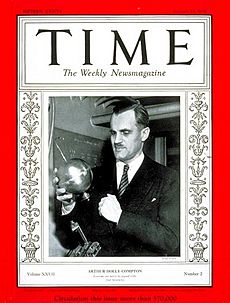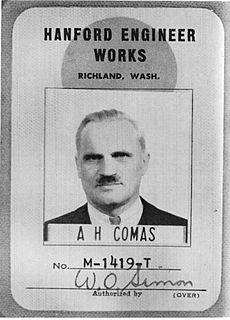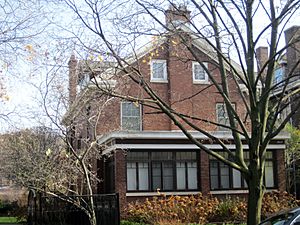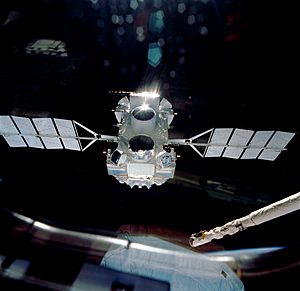Arthur Compton facts for kids
Quick facts for kids
Arthur Compton
|
|
|---|---|
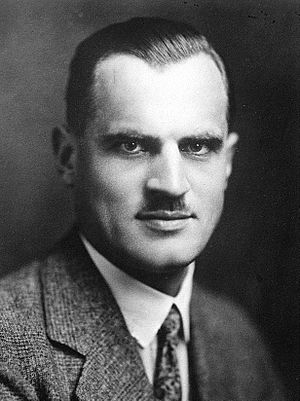
Compton in 1927
|
|
| Born |
Arthur Holly Compton
September 10, 1892 Wooster, Ohio, US
|
| Died | March 15, 1962 (aged 69) |
| Alma mater |
|
| Known for |
|
| Spouse(s) |
Betty Charity McCloskey
(m. 1916) |
| Children |
|
| Awards |
|
| Scientific career | |
| Fields | Physics |
| Institutions | |
| Doctoral advisor | Hereward L. Cooke |
| Doctoral students |
|
| Signature | |
Arthur Holly Compton (born September 10, 1892 – died March 15, 1962) was an American physicist. He won the Nobel Prize in Physics in 1927. This was for his discovery of the Compton effect in 1923. This discovery showed that light acts like both a wave and a particle.
At the time, people knew light behaved like a wave. But the idea that it also had particle properties was new and surprising. Compton also led the Metallurgical Laboratory at the University of Chicago. This was during the Manhattan Project, which developed the first nuclear weapons. After the war, he became the head of Washington University in St. Louis.
In 1919, Compton received a special fellowship to study in England. He went to the University of Cambridge's Cavendish Laboratory. There, he studied how gamma rays scatter and are absorbed. This research led to his famous Compton effect discovery. He also studied X-rays and cosmic rays. He found that cosmic rays are mostly made of charged particles.
During World War II, Compton played a key role in the Manhattan Project. His reports helped start the project. In 1942, he became the head of the Metallurgical Laboratory. His team worked on creating nuclear reactors to make plutonium. They also found ways to separate plutonium and design an atomic bomb. Compton oversaw Enrico Fermi's work on Chicago Pile-1. This was the world's first nuclear reactor, which started working on December 2, 1942.
After the war, Compton became the head of Washington University in St. Louis. During his time, the university allowed students of all races to attend. It also hired its first female full professor. Many veterans returned from the war and enrolled, leading to record student numbers.
Contents
Early Life and Education
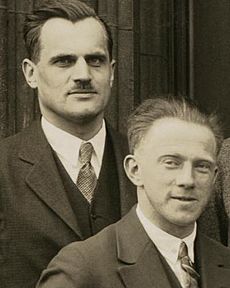
Arthur Compton was born on September 10, 1892, in Wooster, Ohio. His parents were Elias and Otelia Catherine Compton. His mother was named American Mother of the Year in 1939. His family was very academic. His father, Elias, was a dean at the College of Wooster. Arthur also attended this college.
Arthur had two older brothers who were also very successful. His eldest brother, Karl Compton, became president of the Massachusetts Institute of Technology. His second brother, Wilson Martindale Compton, became president of Washington State University. All three brothers earned PhDs from Princeton University. They were the first three brothers to lead American colleges at the same time.
Compton was first interested in astronomy. He even took a photo of Halley's Comet in 1910. Around 1913, he described an experiment that showed Earth's rotation. This device is now called the Compton generator. That year, he earned his science degree from Wooster. He then went to Princeton, where he earned his master's degree in 1914. He completed his PhD in physics in 1916. His research was about how X-rays reflect and how electrons are arranged in atoms.
In June 1916, Compton married Betty Charity McCloskey. She was a classmate from Wooster. They had two sons, Arthur Alan Compton and John Joseph Compton.
Compton worked as a physics teacher at the University of Minnesota from 1916 to 1917. Then he was a research engineer at Westinghouse Lamp Company. There, he helped develop the sodium-vapor lamp. During World War I, he created tools for aircraft.
In 1919, Compton received a special fellowship to study abroad. He chose to go to the University of Cambridge in England. He studied how gamma rays scatter and are absorbed. He noticed that scattered rays were absorbed more easily. Compton was very impressed by the scientists there.
Scientific Career
The Compton Effect
When Compton returned to the United States, he became a physics professor at Washington University in St. Louis in 1920. In 1922, he made a big discovery. He found that X-rays, when scattered by free electrons, had longer wavelengths. This meant they had less energy. The extra energy was given to the electrons.
This discovery is known as the "Compton effect". It showed that electromagnetic radiation (like light and X-rays) acts like particles. In 1923, Compton published a paper explaining this. He said that X-ray photons (light particles) acted like tiny balls hitting electrons. He even wrote a math equation to describe it:
This equation shows how the wavelength of the X-ray changes after it hits an electron. The values in the equation are:
 is the original wavelength.
is the original wavelength. is the wavelength after scattering.
is the wavelength after scattering. is the Planck constant (a very small number).
is the Planck constant (a very small number). is the mass of an electron.
is the mass of an electron. is the speed of light.
is the speed of light. is the angle at which the X-ray scatters.
is the angle at which the X-ray scatters.
The quantity h⁄mec is called the Compton wavelength of the electron. It is a very tiny distance.
When Compton shared his findings in 1923, it caused a big debate. Many scientists believed light was only a wave. The idea that it could also be a particle was hard to accept. But his experiments proved him right. This discovery earned him the Nobel Prize in Physics in 1927.
X-ray Research
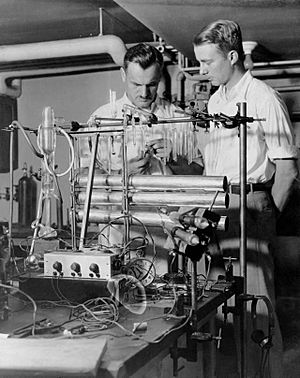
In 1923, Compton moved to the University of Chicago. He became a physics professor there for 22 years. In 1925, he showed that X-rays scattered by certain elements were polarized. This means their waves vibrated in a specific direction.
Compton also studied how X-rays affected salt. He used X-rays to understand ferromagnetism. He concluded that it happens because tiny electron spins line up. In 1926, he started working as a consultant for General Electric. He later helped develop fluorescent lamps based on research he saw in England.
Compton wrote his first book, X-Rays and Electrons, in 1926. It explained how to figure out the density of materials using X-ray patterns. He later updated it with Samuel K. Allison. The new book, X-Rays in Theory and Experiment (1935), was a key reference for many years.
Cosmic Ray Studies
By the early 1930s, Compton became interested in cosmic rays. People knew they existed, but not where they came from or what they were. Compton traveled to many places around the world. He measured cosmic rays at different heights and locations.
He found that cosmic rays were stronger at the Earth's poles than at the equator. Compton believed this was because cosmic rays are mostly charged particles. The Earth's magnetic field affects these charged particles. This was different from what some other scientists thought.
Leading the Manhattan Project
In April 1941, during World War II, Arthur Compton led a special committee. This committee was to report on a program to study uranium. Compton's report in May 1941 talked about the possibility of creating radiological weapons and nuclear weapons. In October, he wrote another report about building an atomic bomb. For this, he worked with Enrico Fermi to estimate how much uranium-235 was needed.
In December 1941, Compton was put in charge of the plutonium project. He wanted to achieve a controlled chain reaction by January 1943. He also hoped to have a bomb by January 1945. To do this, he brought together research groups from different universities. They all worked at the Metallurgical Laboratory in Chicago. Their goals were to build reactors to turn uranium into plutonium. They also needed to find ways to separate plutonium and design an atomic bomb.
In June 1942, the U.S. Army took over the nuclear weapons program. Compton's Metallurgical Laboratory became part of the Manhattan Project. Compton decided which reactor designs the scientists should work on.
When building delays happened, Compton decided to build Chicago Pile-1. This was the first nuclear reactor. It was built under the stands at Stagg Field. Under Fermi's leadership, it started working on December 2, 1942. Compton also arranged for companies to purify uranium and build plutonium factories.
A big challenge came in July 1943. Scientists found that plutonium made in reactors had high levels of plutonium-240. This made it hard to use in a simple bomb design. J. Robert Oppenheimer's team at Los Alamos Laboratory solved this problem. They designed a new type of bomb called an implosion-type nuclear weapon.
Compton was at the Hanford Site in September 1944. He watched the first reactor there start up. Plutonium began to be sent to Los Alamos in February 1945. Throughout the war, Compton was an important science advisor. In 1945, he suggested using the atomic bomb against Japan. He received the Medal for Merit for his work on the Manhattan Project.
After the War
After the war, Compton left the University of Chicago. He returned to Washington University in St. Louis. He became the university's ninth chancellor in 1946. During his time as chancellor, the university made important changes. In 1952, it officially allowed students of all races to attend. It also hired its first female full professor. Many soldiers returned from the war and enrolled, leading to record student numbers. Compton's reputation helped him bring many famous scientists to the university. However, some people criticized him for not making racial integration happen faster.
Compton retired as chancellor in 1954. He continued to teach until 1961. In his retirement, he wrote a book called Atomic Quest. It was about his experiences in the Manhattan Project.
Views on Science and Faith
Compton was a Presbyterian. His father was a Presbyterian minister. Compton believed that science and religion could get along. He said, "Science can have no quarrel with a religion which postulates a God to whom men are as His children."
He gave lectures on "Man's Place in God's World" in 1934-35. These lectures became his book The Freedom of Man. He also wrote about Christian immortality. From 1948 to 1962, Compton was an elder at the Second Presbyterian Church in St. Louis. He believed that Jesus was central to God's plan.
Death and Legacy
Arthur Compton died in Berkeley, California, on March 15, 1962. He passed away from a cerebral hemorrhage. He was survived by his wife and sons. He is buried in Wooster, Ohio.
Compton received many awards during his life. These included the Nobel Prize for Physics in 1927. He also received the Matteucci Gold Medal in 1930. In 1940, he got the Royal Society's Hughes Medal and the Franklin Institute's Franklin Medal.
Many things are named after him. A crater on the Moon is named for him and his brother Karl. The physics research building at Washington University in St. Louis is named in his honor. The university also has a top fellowship for students studying math, physics, or planetary science named after him. Compton also invented a gentler type of speed bump called the "Holly hump." His house in Chicago is now a National Historic Landmark. He also has a star on the St. Louis Walk of Fame. NASA's Compton Gamma Ray Observatory was named after him. The Compton effect is important for the tools on this observatory.
Images for kids
See Also
 In Spanish: Arthur Compton para niños
In Spanish: Arthur Compton para niños


